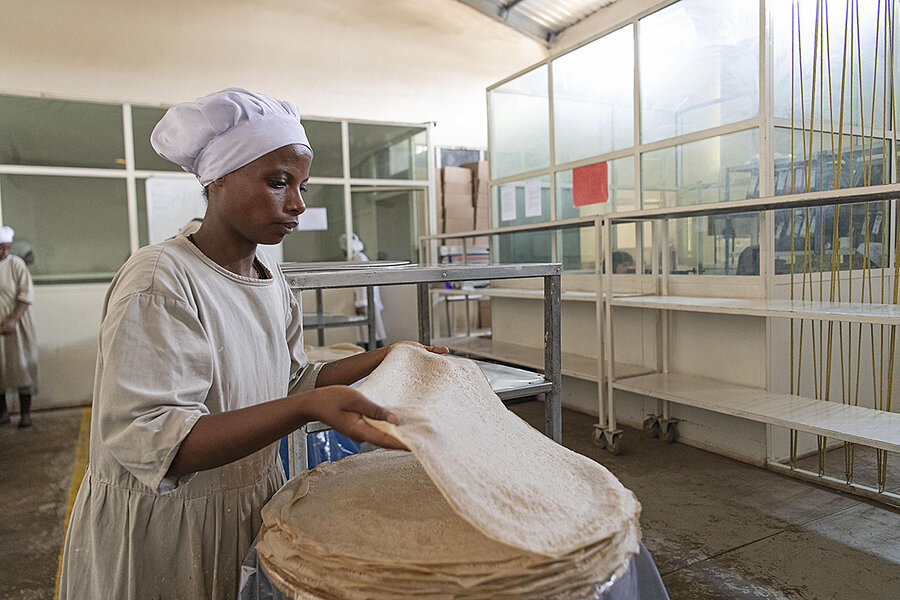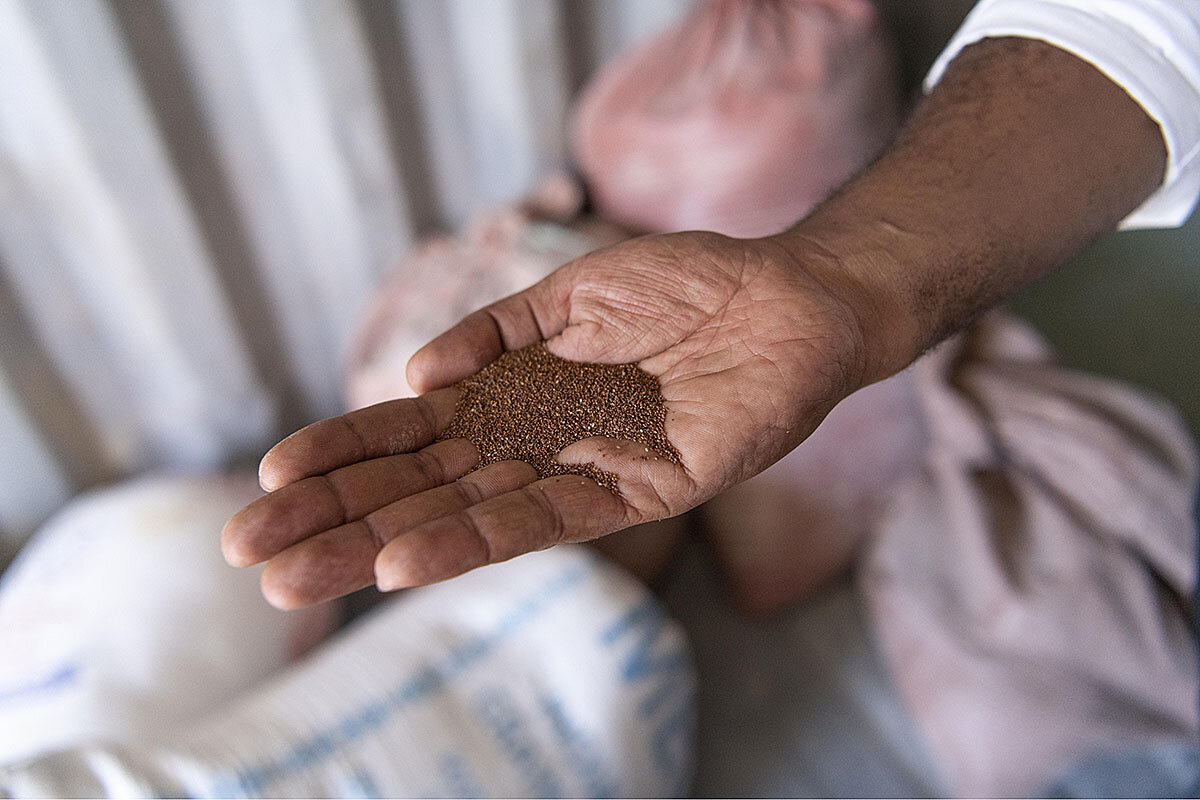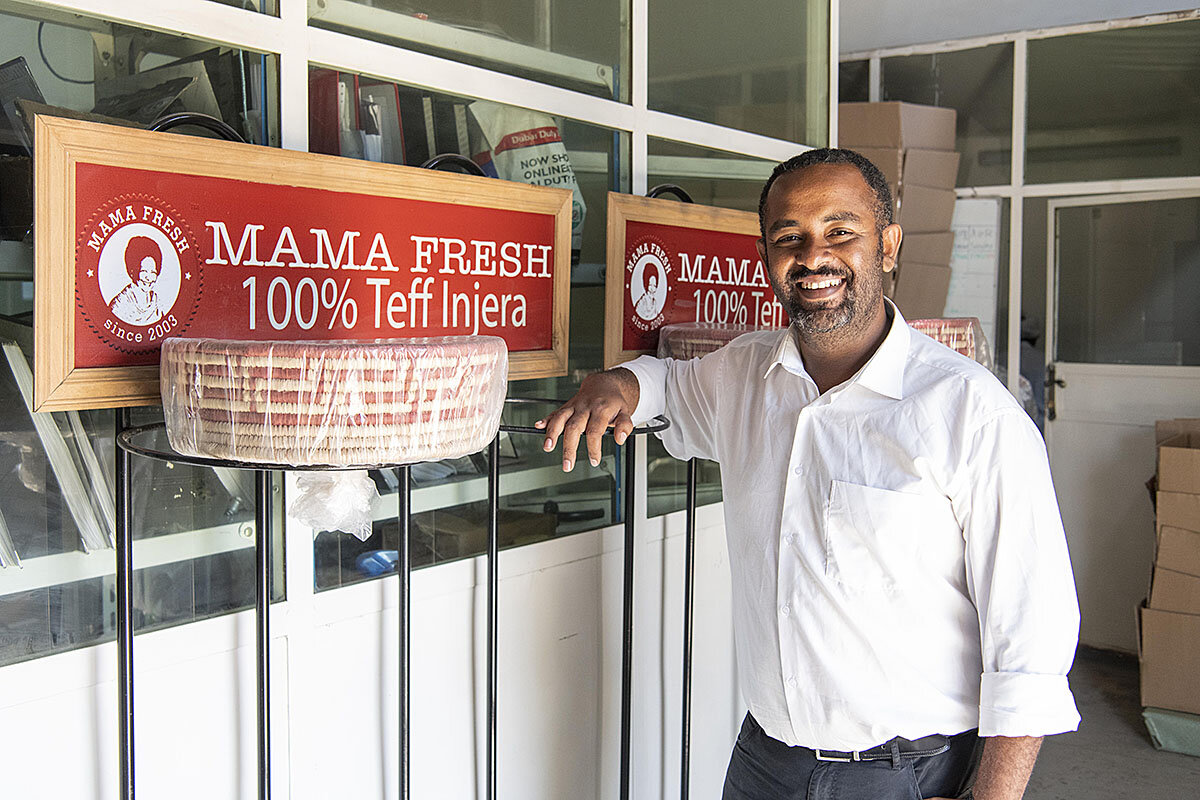Sharing your favorite food with the world isn’t easy. Ask Ethiopia.
Loading...
| Addis Ababa, Ethiopia
Inside the Mama Fresh factory in Addis Ababa, massive vats of fermenting liquid roil and bubble. After several days, when the mixture turns tart and elastic, it will be ladled onto vast griddles, cooked until the edges are crisp, and shipped around the world. This is injera: the spongy, sour bread at the heart of Ethiopian cuisine.
Its foundational ingredient, teff, is the smallest grain in the world, grown much the same way as it was 3,000 years ago. High-fiber, high-protein, and gluten-free, it has potential to be the next “superfood,” say fans around the globe.
Why We Wrote This
In a globalized world, we’ve come to expect sushi in Argentina, K-pop in the U.K. But sharing bits of culture across borders can also raise tough questions about authenticity, fairness, and ownership.
Economically, that sounds like good news for Ethiopia. But teff’s ascent is also a lesson in the complications of having a beloved regional staple go global. The Ethiopian government, for instance, has battled a Dutch agronomist over a European patent on flour made of the ancient grain. Meanwhile, in Ethiopia itself, demand for teff flour continues to be so voracious that the government has been hesitant about allowing much to be exported, for fear that locals could be priced out of a pillar of their diets – and heritage.
“Sharing food with injera, it’s an intimate experience,” says Mirafesilase Hailu, marketing manager of the Mama Fresh factory. “It’s a central part of our culture.”
Just before midnight every night, a truck rumbles out of a dusty industrial suburb of Ethiopia’s capital, bound for the airport with a precious cargo on board.
Inside, dozens of cartons are loaded with injera, the spongy, sour, pancake-like bread that is the foundation of Ethiopian cuisine.
By morning, it will be spread around the world: to the U.K. and the U.S., to Norway, Kuwait, and Canada. Every week, the Mama Fresh factory exports more than 20,000 pieces of its pillowy injera. It is a testament not only to the wingspan of Ethiopia’s vast diaspora and equally vast culinary empire, but also to the preciousness of the bread’s foundational ingredient: teff.
Why We Wrote This
In a globalized world, we’ve come to expect sushi in Argentina, K-pop in the U.K. But sharing bits of culture across borders can also raise tough questions about authenticity, fairness, and ownership.
A tiny crumb of a grain native only to Ethiopia and Eritrea, teff has begun a global rise in recent years, with proponents saying the high-protein, high-fiber, gluten-free grain could be the world’s next “superfood.”
But teff’s ascent is also a lesson in the mixed blessing of being a prospective health food superstar. The Ethiopian government, for instance, has battled a Dutch agronomist over a European patent on flour made of the ancient grain. Meanwhile, in Ethiopia itself, demand for teff flour continues to be so voracious that the government has been hesitant about allowing much to be exported, for fear that locals could be priced out of their own staple.
“Teff has been discovered by the world, and this isn’t a bad thing,” says Zewdie Gebretsadik, a senior technical expert at the Ethiopian Agricultural Transformation Agency who studies teff. “Let the world love it like we love it, but they must also recognize where it came from.”
Teff’s current woes began in 2004, when the Ethiopian government struck an agreement with a Dutch health food company to market teff to superfood-hungry consumers across Europe. As part of the deal, the company and its director, Jans Roosjen, took out a patent on teff flour. Critics called it ridiculous to patent a food “developed over millennia by Ethiopian farmers and community plant breeders,” as the Coalition Against Biopiracy wrote in 2004, dubbing the deal “most outrageous” in its Captain Hook Awards.
The Ethiopian government was meant to get a major cut of the profit from those sales. Instead, Mr. Roosjen’s company went belly up. But he still had the teff patent, which he began using to sell its products under other brand names, cutting the Ethiopian government out entirely.
“You can’t believe how strange it is to hear that the patent for your ancient grain is with a man in Europe,” says Mirafesilase Hailu, the marketing manager for Mama Fresh, the injera factory.
In May 2018, the Ethiopian government announced it was bringing a case against Mr. Roosjen and his patent at the International Court of Arbitration in Paris. Meanwhile, Mr. Roosjen went to Dutch courts to sue another Dutch company, Bakels, for selling its own teff products.
The company had argued that its methods of storing and processing teff were distinct. But in February, the Dutch court found that Mr. Roosjen’s patent hadn’t been valid to begin with. The case in Paris, meanwhile, which covers Belgium, Germany, Britain, Austria, and Italy, has not yet been decided.
Still, the victory in the Netherlands was mostly a symbolic win for the Ethiopians, since the country keeps a tight lid on teff exports. Until 2015, they were banned outright, and their status since has been murky.
Although Ethiopia produces the vast majority of the world’s teff, the country’s current production barely covers domestic needs, Dr. Gebretsadik says. And when a staple food becomes an international superfood, it can put a heavy strain on local supply, driving up prices. (This happened famously in Peru, the home of quinoa, in the early 2000s, though later studies showed it didn’t affect locals’ food security, as initially feared.)
“Our first priority has to be our own people,” he says. “If you don’t have money in your pocket, how can you give anything to a beggar who comes asking?”
Teff, indeed, provides two-thirds of the protein consumed by Ethiopians, and more than 10% of their calories. Just to continue meeting local demand, Dr. Gebretsadik says, the country’s supply needs to increase by 10% annually. To have enough to export, it needs to grow by at least 16%.
That’s a challenge for many reasons, not the least of which is teff’s puny size. The smallest grain in the world, a teff seed is about 1/100th the size of a kernel of wheat. Most sowing is done by hand – in part because teff slides through machines used for other grains – and most threshing is done by oxen. Overall, methods are little different from ones 3,000 years ago.
“The way teff is produced now is very tedious, much less efficient than other grains,” says Dr. Gebretsadik. “But you cannot stop Ethiopians from growing this food. When the Derg [the dictatorial regime in Ethiopia in the 1970s and ’80s] tried, they met hard resistance. People cannot live without this thing.”
The Mama Fresh factory in Addis is proof of that laboriousness. Inside, massive vats of fermenting liquid – made from teff flour, yeast, and water – roil and bubble for several days until the mixture is tart and elastic. It is ladled onto vast griddles and cooked until the edges crisp. Then it is cooled and packed, ready to make its transatlantic journey. (Processed teff products like injera aren’t subject to the same export restrictions as the flour.)
“This country needs exports,” says Mr. Hailu, Mama Fresh’s marketing manager. “Right now European companies making teff products are getting it from places other than here, which is a strange thing to see.”
But for Mr. Hailu, like most Ethiopians, teff is far more than a prospective export.
“Sharing food with injera, it’s an intimate experience. It’s a central part of our culture,” he says. He points to the traditional practice of gursha, literally “mouthful” in Amharic, where family or friends literally feed each other morsels of food wrapped in injera.
For Dr. Gebretsadik, too, the reasons to improve teff farming, or to fight for it in court, have little to do with making the grain accessible to foreigners in search of a health fix. Instead, it’s about the people to whom it owes its long history, wherever they are today.
“When I went to Russia to study many years ago, injera was the thing I was most homesick for,” he says. “The years became long without it.”











